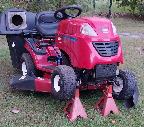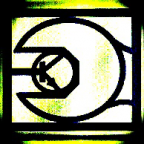*** Restricting New Posts to SD Premium Members ONLY *** (09 May 2025)
Just made a new account? Can't post? Click above.
Air/fuel ratio sensor testing thread
- SailorBob
-

- Offline
- Elite Member
-

One thing I'm interested in is using the downstream O2 for A/F diagnosis. For example, I assume that if the car is running lean, i.e. positive fuel trims, then the downstream O2 should read rich, and visa versa, if the car is running rich, i.e. negative fuel trims, then the downstream should be pegged lean? This assumes the upstream O2 is oscillating more or less normally, and both O2s and the cat are known good.
Does that make sense? Is it true in practice?
I ask, because sometimes all you've got is your scope because your scan tool won't talk to that specific car for whatever reason.
Please Log in or Create an account to join the conversation.
- Andy.MacFadyen
-

- Offline
- Moderator
-

- Posts: 3353
- Thank you received: 1037
The next stage of investigation would be to check if the sensors are actually responding to real conditions and stimulate the sensors by introducing a vacuum leak or adding propane.
The other useful method is to watch what how the sensors compare when responding to the accelerator pedal.
" We're trying to plug a hole in the universe, what are you doing ?. "
(Walter Bishop Fringe TV show)
Please Log in or Create an account to join the conversation.
- SailorBob
-

- Offline
- Elite Member
-

Don't know how to interpret this.
Please Log in or Create an account to join the conversation.
- graywave
-

- Offline
- Elite Member
-

- Adv. Diagnostics New Hampshire
- Posts: 302
- Thank you received: 80
I found this on a couple cars and one was a toyota, I think it was a 2008. Possibly a corolla or Camry. Don't quote me on the year and model but it was a toyota.
I almost thought it had a bad computer since the downstream O2 was reading very lean and was not reacting to propane. Though reving the engine for extended period of time warmed up the O2 enough for it to function normal without the heater until I let off the gas and it immediately seem to slowly loose its reaction. After checking the heater circuit I found there was no control to the O2's heater but the heater in the DS O2 was good. Only while driving did I see heater circuit control on the lab scope from the PCM under specific load conditions.
There was NO codes for O2 heater circuit or Catalytic converter but was a p0171 which seemed to go away after doing intake manifold gaskets. I was trying to verify the upstream AFR via the DS readings but couldn't.
Oxygen sensors need to hit specific temperatures to function correctly. If the heater is active and pulling current I would be looking for small exhaust leaks with a stethoscope (open tube end).
If the engine is lean, you may or may not see it in the ds O2 sensor depending on how lean the engine is. If its maxed lean (max positive correction) you might see it stay lean, may not switch up and down. If you ever see a DS o2 switching, you may have an issue with the CAT.
How I understand narrowband o2 sensors is the "switching" comes from the computer adding fuel when the reading is lean and taking away fuel when the reading is rich which causes the switching we see. Since these o2 sensor only register within a very narrow AFR window the exhaust mixture needs to be "close" (within limits) to stoich for it to start switching. If its only being used to monitor the cat, if the cat is working you may never see it switch unless the cat is flooded with O2 and the reading is then lean and suddenly the mixture goes rich.
Confirm what it's not, and fix what it is!
Please Log in or Create an account to join the conversation.
- Flatrater
-
- Offline
- Senior Member
-

- Posts: 48
- Thank you received: 18
The biggest difficulty I see with AF sensors is how the output is reported in the data stream. But even that I don't see as an obstacle when technicians are taught to understand fuel control properly. I think a real issue here is that most technicians are not able to be dedicated to only driveability. They often have to service not just the whole vehicle, but chain saws, tractors, and whatever the heck comes in the door.
90+% of an AF sensors circuitry is in the ECM, not the sensor.
Zirconia O2 sensors do more than just switch above and below stoich. 800mv is not the same as 900mv for example. You can see this by spending time looking at downstream sensor output and watching NOx numbers. A slightly biased rich mixture produces much less NOx without a mileage penalty. A zirconia sensor can do that.
Much of what has been requoted all over the web concerning zirconia and AF sensors is really old information. AF and O2 sensors were used for many years before much research was done concerning their operation in the field over time. Significant changes came along after the research, some of which is fairly recent.
AF sensors are comparatively slow and their use requires a different fuel control strategy, which at the end of the day, means managing the catalyst. GM, for example, is not "behind" because they primarily use zirconia sensors upstream. It is by choice and it is cheaper when you can handle the required software.
A zirconia sensor can do a pretty good job of targeting mixtures above or below stoich when needed, and have for some time.
AF sensors are not used to run lean air fuel ratios for any length of time in the US, doing so would deactivate the catalyst and require a NOx trap.
AF sensors "switch" (in a sense) or "are switched" just like zirconia sensors. Most do not see this because they are not zooming in properly. While a perfectly stoich mixture makes the catalyst more efficient, one that moves slightly higher and lower than stoich will widen the range of catalyst efficiency.
The equivalence ratio pid found on the generic side of the scan tool is actually lambda. The engineer in charge of that (inside information) made a mistake as equivalence ratio is the opposite of lambda. It is the fuel-air ratio, not the air-fuel ratio.
If you're wondering why more indepth information isn't generally available, I can tell you why. It costs $$, research is really tough, and no one (technicians) wants to pay for it.
Please Log in or Create an account to join the conversation.
- TheTechWhisperer
-

- Offline
- Senior Member
-

- Posts: 55
- Thank you received: 47
For example, I have only learned 2 of these variations thoroughly. The problem is that you unknowingly get a false sense of confidence, and tailor your expectations to the premise that "they all kind of work the same". In theory, they do... BUT, when it comes to interpreting enhanced PIDs, they really do have some crucial differences! AND that's even without the added twist of plugging in 2 scanners and getting different data, haha (not going to open that can of worms).
One thing is certain in this business: Maintaining the careful balance between confidence and humility is the recipe for success. The second that balance tilts too far one way, a car and/or your paycheck will remind you.
"You will always find the greatest fulfillment in life when you are operating in the gifts God gave you"- Dad
National Director of Technical Training & Mechanical Operations - Express Oil Change & Tire Engineers
ASE Master L1 Tech
BMW Master Tech
Ford FACT Advanced Electronics Instructor
Please Log in or Create an account to join the conversation.
- Noah
-

- Offline
- Moderator
-

- Give code definitions with numbers!
- Posts: 4934
- Thank you received: 1100
TheTechWhisperer wrote:
One thing is certain in this business: Maintaining the careful balance between confidence and humility is the recipe for success. The second that balance tilts too far one way, a car and/or your paycheck will remind you.
Well put.
"Ground cannot be checked with a 10mm socket"
Please Log in or Create an account to join the conversation.
- Tyler
-
 Topic Author
Topic Author
- Offline
- Moderator
-

- Full time HACK since 2012
- Posts: 6049
- Thank you received: 1522
Flatrater wrote: If you're wondering why more indepth information isn't generally available, I can tell you why. It costs $$, research is really tough, and no one (technicians) wants to pay for it.
I will. :ohmy: But I couldn't find any training that told me what I really wanted to know.
Wow, this is a really nice piece you wrote here Tyler. I don't get on this forum as often as I should, I'm going to have to change that!
Thanks! Please feel free to add any insights you have on the A/F sensors you're familar with, if you want. This thread is far from comprehensive. :lol:
Please Log in or Create an account to join the conversation.
- ScannerDanner
-

- Offline
- Administrator
-

- Religion says do, Jesus says done!
- Posts: 961
- Thank you received: 498
Don't be a parts changer!
Please Log in or Create an account to join the conversation.
- Tyler
-
 Topic Author
Topic Author
- Offline
- Moderator
-

- Full time HACK since 2012
- Posts: 6049
- Thank you received: 1522
Please Log in or Create an account to join the conversation.
- chasencai
-
- Offline
- New Member
-

- Posts: 7
- Thank you received: 3
Please Log in or Create an account to join the conversation.
- Dylan
-

- Offline
- Moderator
-

- Belgium, Europe
- Posts: 1461
- Thank you received: 327
Please Log in or Create an account to join the conversation.
- Noah
-

- Offline
- Moderator
-

- Give code definitions with numbers!
- Posts: 4934
- Thank you received: 1100
"Ground cannot be checked with a 10mm socket"
Please Log in or Create an account to join the conversation.
- Orchid70
-
- Offline
- Junior Member
-

- Posts: 21
- Thank you received: 1
THIS is what I missed in the SD training book!!
Nothing about wideband O2.
So I measured the first lambda as it was narrow band - changed it - and got the same flat line..... Volvo V70 MK2 from 2001.
THEN I found this

The idle is fine when MIL is lit.... except when the coolant fan runs.
Please Log in or Create an account to join the conversation.
- Orchid70
-
- Offline
- Junior Member
-

- Posts: 21
- Thank you received: 1
Volvo V70 (2001<) uses Lambda units for STFT and LTFT and not % per cents!
So I can have:
STFT: 0,98
LFTF: 1,02
At idle at 750 rpm
SO Im guessing that would equal to:
-2%
2%
That Lambda 1 is 0.
Anyone knows? I do have pictures from both Vida and SnapOn.
Please Log in or Create an account to join the conversation.
- Tyler
-
 Topic Author
Topic Author
- Offline
- Moderator
-

- Full time HACK since 2012
- Posts: 6049
- Thank you received: 1522
But, most every application I've seen of Lambda PIDs works exactly as you described.
Please Log in or Create an account to join the conversation.
- Orchid70
-
- Offline
- Junior Member
-

- Posts: 21
- Thank you received: 1

This bloody car needs to be resett by taking off the battery negative - emptying every possible memorey by leaving it off long enough or turning the start key - after that this (quote from VIDA) - this after changing any faulty parts on fuel/air/exhaust system as well as erasing the codes:
The rpm is high/low during engine braking to a stop. This is so because idle control needs time to learn how much air the engine needs when the engine runs at idle. The adaption takes place every time the engine idles. Only a limited amount of adaptions is allowed each time. This means that you have to leave idle every once in awhile for the system to finish adapting.
One way to do that is to run the engine warm and then let it idle. If the vehicle is equipped with automatic transmission, gear position D (drive) shall be used.
With some minute's interval, load the engine a little by revving it for a few seconds. Then you let the engine return down to idle.
Test-drive the vehicle to decide if the system has finished adapting or not.
END quote.
Please Log in or Create an account to join the conversation.
- MattH
-
- Offline
- New Member
-

- Posts: 3
- Thank you received: 0
Please Log in or Create an account to join the conversation.
- Dylan
-

- Offline
- Moderator
-

- Belgium, Europe
- Posts: 1461
- Thank you received: 327
MattH wrote: Wow! How am I just now seeing this? Great explanation Mr. Danner! Can't thank you enough for your industry contributions.
Don't forget to thank Tyler who has put so much effort into this thread
Please Log in or Create an account to join the conversation.
- Lowboybrian
-
- Offline
- New Member
-

- Posts: 11
- Thank you received: 1
Please Log in or Create an account to join the conversation.

